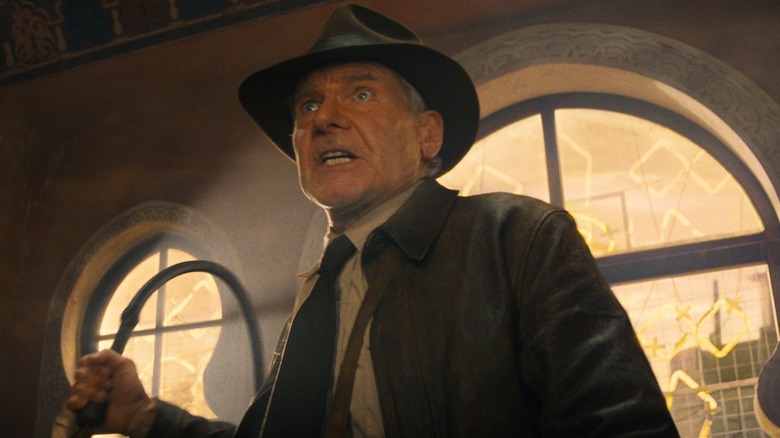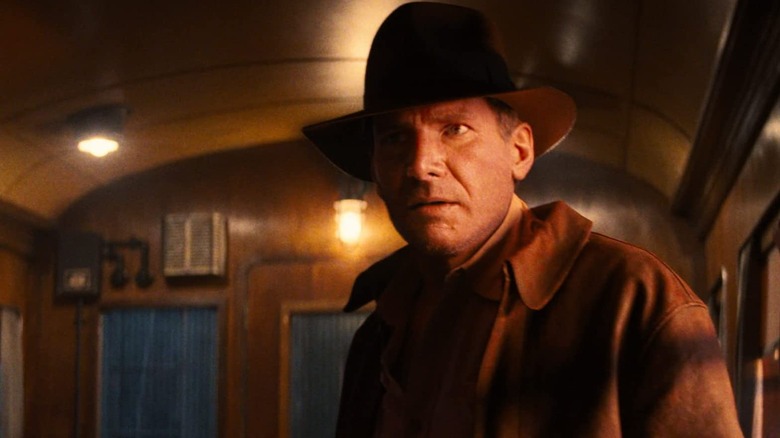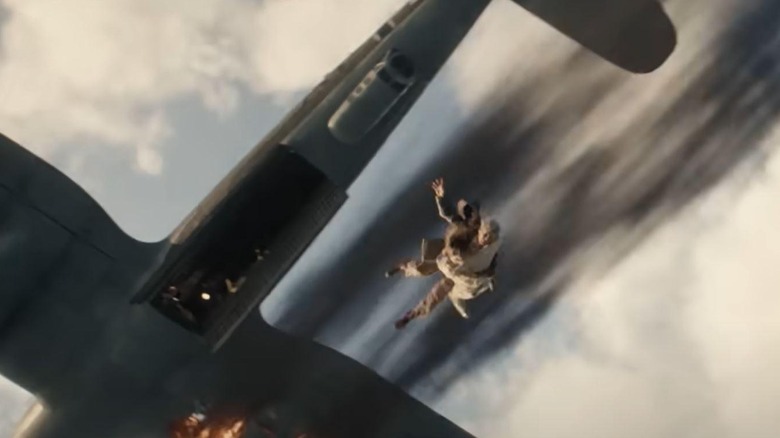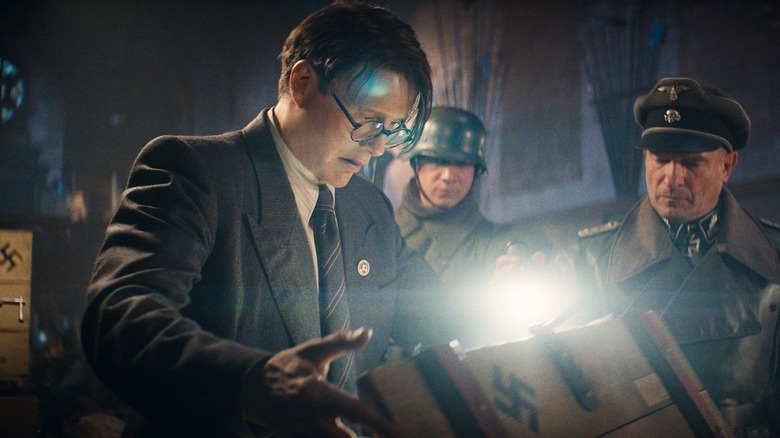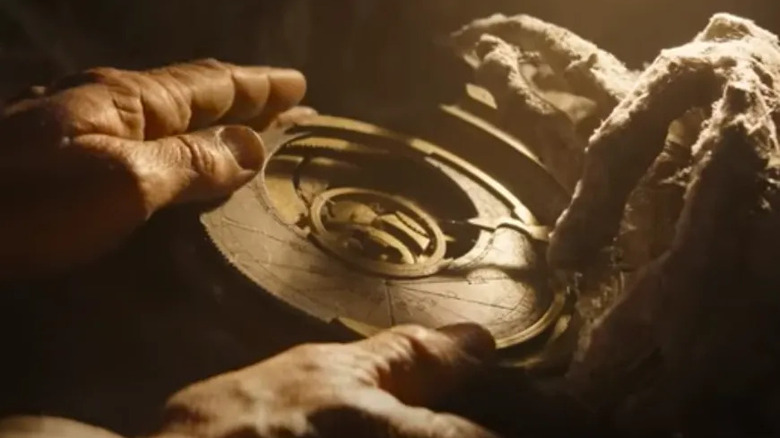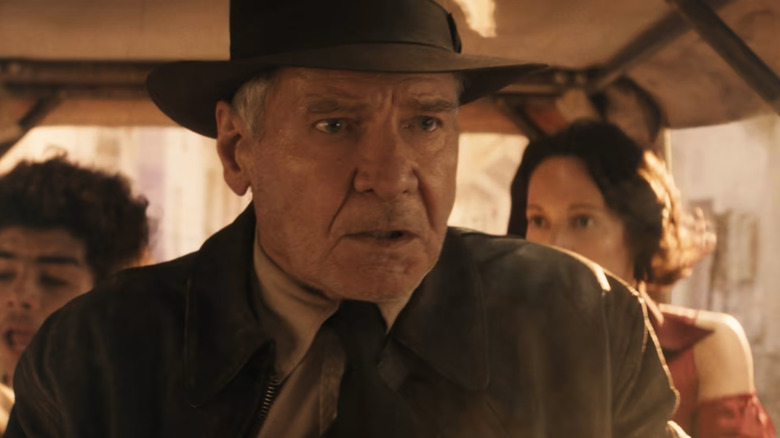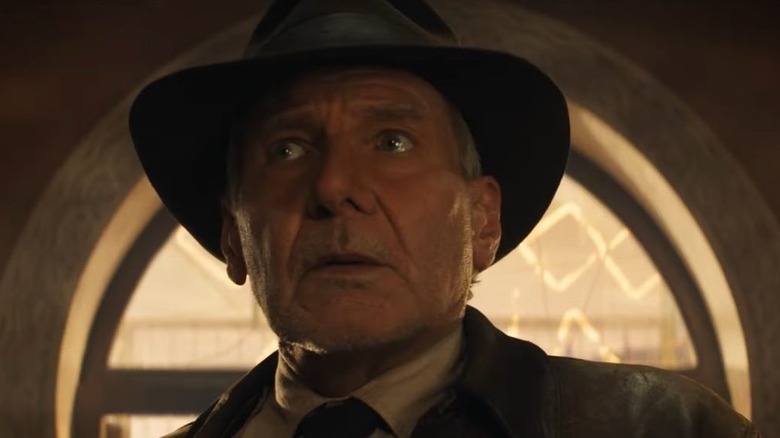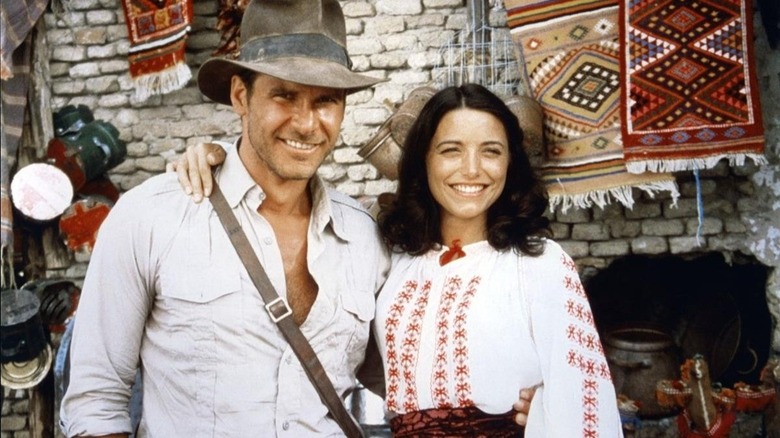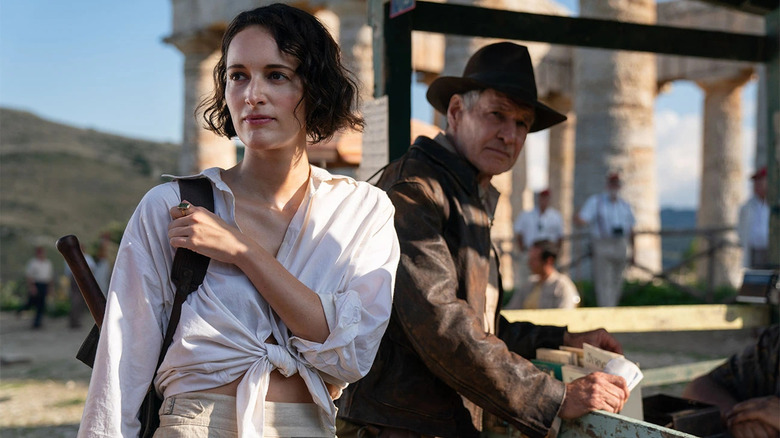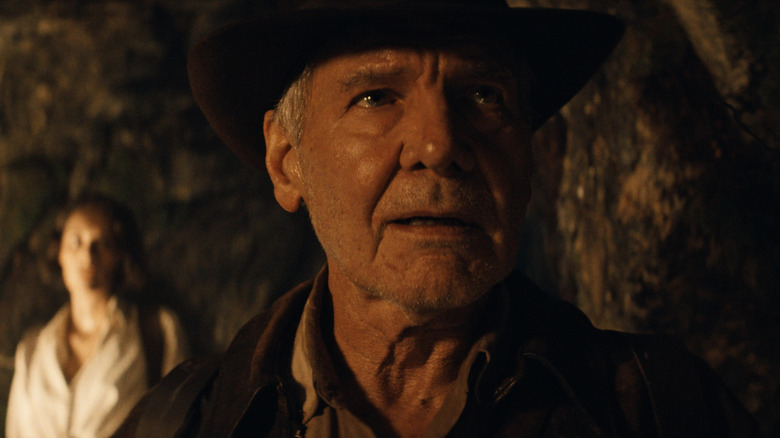The Ending Of Indiana Jones And The Dial Of Destiny Explained
This article contains SPOILERS for "Indiana Jones and the Dial of Destiny."
"Indiana Jones and the Dial of Destiny," the fifth film in the series created by Steven Spielberg and George Lucas, has been designed by writer-director James Mangold and co-writers Jez Butterworth, John-Henry Butterworth, and David Koepp as a conclusion to the cinematic adventures of the whip-wielding, Nazi-fighting archeologist played by Harrison Ford. The only film in the series without Spielberg directing (he and Lucas still hold executive producer credits), the movie as a whole is a mixed bag, lacking the consistent verve of the original trilogy.
However, as a farewell tribute to the beloved character, it's ultimately successful. If the rest of "Indiana Jones and the Dial of Destiny" had the same mix of cleverness, absurdity, and genuine heart as its final act, there's a very good chance the critics would be a lot more positive about it than they have been. This article will delve into what exactly happens during the film's ending, how it works in spite of (or even because of) its utter ridiculousness, and how it wraps up Indy's character arc.
What you need to remember about the plot of 'Indiana Jones and the Dial of Destiny'
"Indiana Jones and the Dial of Destiny" begins in 1944, wherein Indiana Jones (Harrison Ford, digitally de-aged for the flashback scenes) and his ally Basil Shaw (Toby Jones) are on a mission to rescue treasures stolen by Nazis on a train. Some of these "treasures" are fake, but one is the real deal: half of the Antikythera, or "Dial of Destiny," created by Archimedes and more technologically advanced than anything else that would be made for centuries.
The film's main action occurs in 1969. Now, Indy is an old and jaded professor, Basil is dead, and one of the Nazis from the train, Jürgen Voller (Mads Mikkelsen), is a NASA rocket scientist working on the moon landing. Having conquered space, Voller now wants to conquer time and is seeking out the Antikythera. Also seeking it is Basil's daughter and Indy's goddaughter Helena (Phoebe Waller-Bridge), nicknamed "Wombat," who reenters Indy's life after a long time away.
When Voller frames Indy for the murder of two colleagues, the aging archeologist once again dons his fedora and embarks on a globe-trotting adventure to find the other half of the Antikythera before the Nazis do. Wombat is both Indy's companion and foil, with her greed and gambling debts bringing trouble. Young thief Teddy (Ethann Isidore) and diver Renaldo (Antonio Banderas) help out, though the latter gets killed. Eventually, they find the Dial's other half in Archimedes' hidden tomb in Sicily.
What happens at the end of 'Indiana Jones and the Dial of Destiny'
The Nazis come in hot on Indy and Wombat's trail, using information from the kidnapped Teddy to find the tomb. The nature of the Antikythera and Voller's planned use for it is explained — it tracks rips in time, and Voller is going to use it to travel back to Sicily on August 20, 1939, for the purpose of killing Hitler so that the invasion of Poland doesn't happen, and the Third Reich can continue to gain power without their ultimate defeat in World War II. The Nazis take Indy hostage and fly their plane into the rift, though fortunately, Wombat sneaks onto the plane via motorcycle and Teddy hijacks another plane to chase them ... without realizing the pilot is still inside, which causes some comedic awkwardness.
The Antikythera actually ends up leading everyone back in time to the Siege of Syracuse in 213 B.C. – the only place it goes. The Nazis are easily dispatched amidst this Greco-Roman battle which Indy teaches about earlier in the film. Indy wants to stay in the ancient past, but Wombat brings him back home where he reunites with his old love Marion Ravenwood (Karen Allen).
So wait, was Indy going to save Hitler?
Had the calculations on the Antikythera worked the way Voller planned, then we could have had the very awkward scenario of beloved Nazi fighter Indiana Jones trying to save the life of Adolf Hitler to stop Voller or someone else from becoming an even more powerful Nazi Führer. Even considering how common "Would you kill Hitler?" debates about the ethics of time travel are, this would be a strange plot. However, even before the Antikythera leads them to Roman times, Indy has reason to suspect there's never any risk of Voller successfully reaching his intended destination to begin with.
The reason? Continental drift. The map of the world in Archimedes' time was not the same as the map that exists in 1969, and the ancient Greeks didn't have any concept of plate tectonics that would allow them to predict how geography subtly shifts over time. Even if Archimedes had knowledge of the future, it would seem pretty unlikely that he'd be able to account for all of that. As Indy explains this to Voller on the plane, he laughs about it all, embarrassing Voller for the oversight. If the plane wasn't already so close to the time rift, they might've even turned back.
Was the Dial a paradox?
The writers of "Indiana Jones and the Dial of Destiny" were clearly aware of the intrigue of time paradoxes while equally aware of their potential to frustrate an audience. As such, the movie ends up almost creating a time paradox when Archimedes ends up finding the completed Antikythera, but the filmmakers thought ahead and added some workarounds to more or less maintain the integrity of the plot.
The first potential paradox that has to be avoided is the idea that the Antikythera came from Archimedes seeing his own work from the future. He is shown building the device even before Nazis start falling from the sky, which means the idea for the Dial predates the time travel. The other paradox the movie dodges is Archimedes keeping the Dial after he finds it without ever actually making it himself, which would cause the object to lack any origin. Wombat shuts this down intentionally by taking the Antikythera away from him and telling him he needs to build his own.
Now, it is still possible that there's some element of time paradox in all this. Even if Archimedes didn't get the idea for the object, nor the object itself from the future, having seen the completed work means it's possible his nonexistent future self still gives him the clues to how to make it. This paradox, however, is potentially avoidable, and even if it does exist, it's smaller than either of the paradoxes the movie avoids.
Does the time travel story make any sense?
Do the mechanics of the rifts in time make scientific sense? No, they do not, but looking for scientific logic in an "Indiana Jones" movie is a fool's errand. Magic exists in this universe, and — as much as some fans may want to deny the existence of "Indiana Jones and the Kingdom of the Crystal Skull" – so do aliens and the ability to survive a nuclear blast inside a refrigerator. The time travel story here isn't a much bigger stretch, and it's the only such huge stretch in a movie that arguably plays things a bit too safe otherwise.
Perhaps in reaction to negative feelings over "Kingdom of the Crystal Skull" getting a bit too silly, "Dial of Destiny" generally feels a bit too restrained, overly reverent towards nostalgia and content to repeat the greatest hits from prior movies. The time travel ending may be considered a "nuke the fridge" moment, but it is also the one part of the new sequel that feels genuinely fresh and bold. It works despite not fully making sense because it's both entertaining in its absurdity and emotionally fitting for a story about an aging man so obsessed with the past that he no longer feels at home in the present.
Why Indy wants to stay in the past
70-year-old Indiana Jones is characterized as a man who feels out of sync with the changing world around him. His hippie neighbors know him as the cranky old guy who tells them to keep their music down. His students don't pay attention in class. He's not even excited about the moon landing, which you'd assume would inspire at least some wonder – though to be fair, his disinterest is vindicated by the fact his old enemies are working at NASA now. His only connection to the popular zeitgeist of the late '60s is in vocally opposing the Vietnam War, and he has a very tragic reason for that — his son Mutt enlisted and got killed, and grief over the loss led to the dissolution of his marriage to Marion.
Traveling back in time to the same battle he was desperately trying to make his students care about is like a dream for Indy. He's willing to succumb to his injuries and die in this "dream" because he's always been in love with the past and has grown to feel increasingly lost in the present. He's getting on in years and endured far more near-death experiences than most people could ever imagine, so he's had plenty of time to make peace with the idea of his death. On some level, he also feels that by staying behind, he's making a sacrifice that helps Wombat and Teddy get home safely.
Why Indy has to return to the present, and why the ending is so moving
Indy's goddaughter, of course, won't tolerate this attempt at self-sacrifice. She clocks Indy right in the face, and by the time he regains consciousness, he's already in his own bed with his wounds bandaged up. He's initially upset about having been saved against his wishes, claiming he has nothing left to live for. Wombat presents a clear counterpoint to this belief by inviting over others who care about him: Teddy, Sallah (John Rhys-Davies) and his family, and most significantly of all, Marion.
When Sallah takes his kids out for ice cream to give Indy and Marion some alone time, the couple that broke up due to intense pain find that their love is able to get them through the pain together. When asked about his injuries, Indy says that "everything hurts." Marion says the same is true for her, but points to her elbow as one thing that doesn't, and Indy kisses it. She then points to her collarbone – another kiss. Soon they're making out. This is fan service done right: a reversal of the iconic kiss scene from "Raiders of the Lost Ark" that also works perfectly as a romantic happy ending.
What about those alternate ending rumors?
In December 2022, composer John Williams hinted that there might have been an alternate ending in the works for "Indiana Jones and the Dial of Destiny." Rumors circled about what this alternate ending could possibly involve, only for James Mangold to immediately shut down those rumors on Twitter, definitively stating, "We're not shooting & never shot any new scenes or 'alt endings'. Our film is 99% finished, getting rated by MPAA & VFX being completed." Given how the whole basic point of the film is based around it all working towards the ending, it makes sense that the ending we got would have been decided upon well before shooting.
It's worth noting, though, that a Harrison Ford interview with Espinof suggests there may have been at least a bit of reworking of the final scenes. "We did a little work on the ending," Ford said, "which was the last thing that I shot, with Karen Allen."
Funnily enough, the two most prominently rumored alternate endings turned out to be the exact opposite of what happens in the actual movie. One rumored ending had Indiana Jones dying, while another involved Wombat replacing him. The actual ending makes a big point about how Indy needs to keep living, and rather than passing anything on to Wombat, the film's final iris shot on Indy grabbing his fedora from the laundry line serves to emphasize that he is both fully himself and not handing anything off to someone else. It would almost seem as if these rumors of false endings might as well have been leaked to hide the actual ending.
What the ending means for the 'Indiana Jones' franchise
Though we can't truly say for certain that another sequel will never happen, it's all but certain this is going to be the final "Indiana Jones" movie. Like James Mangold's prior blockbuster "Logan," this is a movie about an old man reflecting upon his life and finding some sense of closure. Unlike in "Logan," this closure doesn't involve death, which means it's not an absolute franchise ender, but this feels like it's meant to be a definitive happy ending for Indiana Jones. It's interesting that between this and "Guardians of the Galaxy Vol. 3," Disney has released two summer blockbusters that offer a firm sense of conclusion for their respective franchises without killing any main characters to give their stories a more absolute sense of finality.
With Harrison Ford now 80 years old and the studio having no interest in recasting Indy, the only plausible future for the franchise would be spinoffs focused on other characters in this universe. Phoebe Waller-Bridge's Wombat is a charismatic enough new character that she could certainly carry a Disney+ show of her own, and there's also those constant fan demands for Ke Huy Quan to reprise the role of Short Round as an adult. Even then, there are rumors that LucasFilm is now focusing exclusively on "Star Wars," so even the most promising "Indiana Jones" spinoff ideas are extremely unlikely.
